I was recently featured in the Sunday Express-News Real Estate cover article. Several of our listing were also highlighted.
Downtown Houses. Charm, space in urban homes
By Ana Ley
aley@express-news.net
Sunday, December 19, 2010
People seeking the excitement of an urban pad often have to compromise on living space. But there are plenty of places to find single-family homes just south of downtown.
This area is ideal for people who seek a social environment and a central location. Houses there are generally older and have interesting architectural details, and they usually are close to restaurants and the art scene. They’re also roomier than the apartments and condominiums traditionally associated with downtown.
“There’s always something to do, and everything is so close and walkable,” said Curtis Bowers with King William Realty, who has lived in the Lavaca Historic District for the past four years. “It’s unlike anywhere else in San Antonio.”
The King William Historic District offers homes from around the $200,000s to multimillion-dollar mansions. The 25-block area on the south bank of the San Antonio River was the most elegant residential area in the city in the late 1800s, according to the King William Association. Prominent German merchants originally settled the area, which was zoned as the state’s first historic district.King William also has two districts recognized by the National Register of Historic Places, as well as individual properties that are recognized for their historical significance.
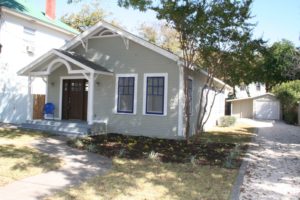
The 526 Mission Street home, located in the King William Historic District near the Eagleland segment of the River Walk and the Blue Star Arts Complex, has been remodeled and features a single gar garage with two off-street parking spaces. the home's French doors open onto a large deck and yard. Listing price is $229,000.
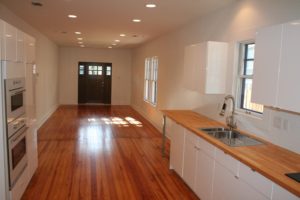
This contemporary renovation at 526 Mission St. in King William has two bedrooms and two bathrooms. Built in 1940, it has plenty of natural light and Ikea kitchen appliances.
The Germans who moved to San Antonio began building mansions with various architectural styles, such as Greek Revival, Victorian and Italianate. Ernst Altgelt, the first to build on current-day King William Street, is believed to have named the street after King Wilhelm I of Prussia.
In the 1920s, many of the mansions were turned into apartments, and young professionals eventually rediscovered King William and began a renaissance that continues to this day. The district was expanded in 1984 to include a neighborhood of cottages south of Alamo Street.
“The biggest attraction is the historical homes,” said Zet Bear with the King William Association.
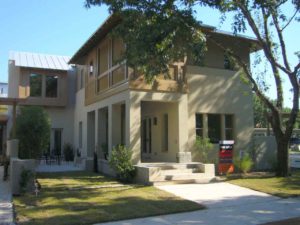
The garden home, at 414 Madison St., has an open-entry gallery with a large side courtyard. The three-bedroom, three-bath house has a large screened balcony off its master bedroom. The home also has high ceilings and polished concrete floors. It has a listing price of $659,000.

This garden home is at 414 Madison St. It has an open-entry gallery with a large side courtyard. The three-bedroom, three-bath house also has a screened balcony.
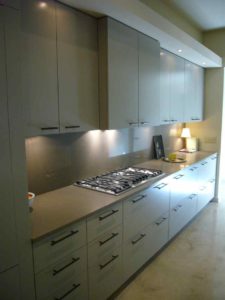
The Madison Street garden home has high ceilings and polished concrete floors. It has a listing price of $659,000.
Lavaca, just east of King William, is a more affordable alternative. Homes there currently are priced from the $70,000s to about $500,000.
The area is a hub for local artists, and residents say its diversity makes it one of the most vibrant places in San Antonio. Many older houses there have been remodeled by homeowners, creating a collage of individual tastes and colors.
Bowers’ Lavaca home is a yellow Victorian that he and his wife decorated with modern art created by artists from the area.
“We have a friend who’s an art dealer,” Bowers said. “We’ll walk around at night and always run into friends.”
Lavaca’s residential sector is also among the oldest in the San Antonio area that has survived into modern times. The neighborhood is surrounded on the north by East Durango Boulevard, on the south by the Union Pacific railroad tracks, on the east by U.S. 281, and on the west by South St. Mary’s Street.
Architecture in the neighborhood is defined by small 19th-century vernacular houses built primarily by working-class families beginning in the early 1870s. Around this time, San Antonians were building bigger homes nearby in the King William neighborhood. Among the neighborhood’s original residents were carpenters, stonemasons, shopkeepers, clerks, tailors, bartenders, teamsters and butchers.
The houses are mostly one story with some two-story buildings scattered throughout the area. They range from very simple homes to highly decorated ones, from stone cottages to Victorian and Craftsman houses. There also are a few Neoclassical homes in the area.
King William and Lavaca are divided by a region commonly referred to as Southtown, the area’s commercial corridor, which is home to popular spots such as the Blue Star Contemporary Art Center, the Sterling Houston Theater and Mad Hatter’s Tea House & Café.“It has an eclectic lifestyle,” said René Guerrero, former president of the Southtown Chamber of Commerce and King William resident. “And you get to enjoy the quiet part of the River Walk.”
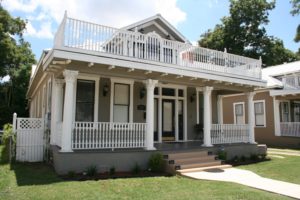
Built in 1920, this four-bedroom home is steps away from the River Walk and has an upstairs balcony with a view of downtown San Antonio. Historic features include a stone fireplace and a coffered ceiling. The house, at 206 E. Arsenal St., has off-street parking with room for a garage. The 2,409 square-foot home is priced at $415,000.
Mike McClain, a former suburbanite, said he enjoys downtown area living because of the area’s contemporary art community. The Dallas native is living at the Pearl Brewery complex while he and an architect design a new home in the downtown area.
“There’s just a lot of wonderful culture,” McClain said. “The thought of having short commutes to galleries and art shows is just so appealing.”
